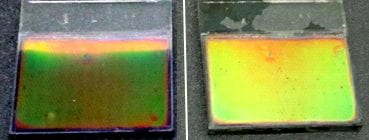Researchers report the first example of an electrochromic Bragg mirror based on nanoporous multilayers of nickel oxide and tungsten trioxide nanoparticles.
Electrochromic materials change their color by electrically induced storage of ions and electrons in the material. This storage can be reversed by applying an opposing electrical bias.
Two prototypical electrochromic materials are tungsten trioxide, W(VI)O3, and nickel oxide, Ni(II)O.
Now, for the first time, both materials have been combined in a single photonic crystal architecture, where tungsten trioxide is the high refractive index component and nickel oxide the low refractive index component.
In contrast to electrochromic photonic crystals based on a single material, an applied potential does not lead to a strong spectral shift of the photonic stop band. Instead, the device behaves as an electrochromic Bragg mirror, where the reflectance can be modulated by the applied potential.
This reflectance modulation may be useful for tunable mirror devices and for grayscale control in reflective displays, such as ebooks.
The research was reported in Advanced Optical Materials, a new section in Advanced Materials dedicated to breakthrough discoveries and fundamental research in photonics, plasmonics, metamaterials, and more, covering all aspects of light-matter interactions. To get Advanced Optical Materials email alerts: click here.
The paper, “Electrochromic Bragg Mirror: ECBM”, is free to download for a limited time.


















